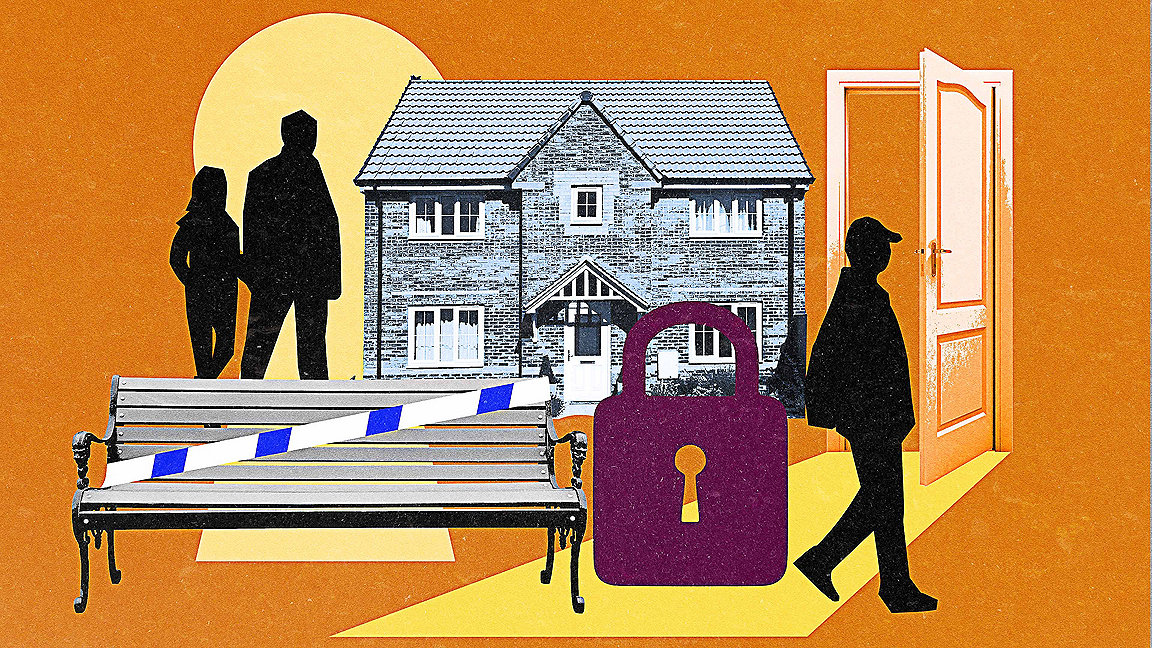
UK Police security initiative Secured by Design (SBD) was created in 1989. It aims to reduce crime by improving the physical security of buildings and incorporating crime prevention measures into the layout and landscaping of new developments, such as maximising natural surveillance and limiting excessive through-movement.
However, the SBD programme has been criticised by some urbanists, who doubt its efficacy and argue that in some cases it runs contrary to the principles of good urban design, undermining attempts to promote community cohesion that might have a more enduring impact on reducing crime and antisocial behaviour.
Phineas Harper, chief executive of Open City, a charity dedicated to making architecture and neighbourhoods more accessible and equitable, argues that SBD is sometimes responsible for excessive or harmful actions. He cites examples such as seating and shrubbery being removed from a park in Ashford, Kent to prevent antisocial behaviour, and paths and cycle tracks being excised from the design of a housing scheme in Sussex to block potential escape routes for thieves.
“Do the police really have any expertise when it comes to what makes a community a good place to live?” asks Harper. “This set of guidelines has been created by an organisation that is only focused on one or two priorities. And when those guidelines are applied, overruling all counter-arguments or context, it can lead to some quite negative outcomes for communities.”
Planning policy guidance states that all schemes should aim to create a safe and secure environment. The police are also a statutory consultee for all UK planning applications, with plans scrutinised by a Designing Out Crime Officer (DOCO) who can make recommendations that the design should be altered in line with published SBD design guides on residential, commercial and public buildings.
“Just because you might have one or two bad actors in the built environment doesn't mean that everybody else should suffer as a result. To design to meet SBD standards, you end up doing things that are diametrically opposed to good placemaking,” says Russell Curtis, cofounder of architectural practice RCKa.
He says that as part of an affordable housing scheme in London, his practice designed an open space between two blocks, aimed at encouraging neighbours to meet and socialise. But a DOCO suggested that it would provide too many escape routes for criminals, resulting in it being redesigned as a gated area. “We were able to make a late change that was acceptable to the planning authority, but it was detrimental to the project.”
While the advice of DOCOs does not have legal force, inexperienced planners in under-resourced local authorities are often reluctant to gainsay it, argues Curtis, even where there are benefits that might outweigh a perceived increase in the risk of crime. Meanwhile developers are fearful of providing grounds for objections that might see their projects refused consent.
SBD guidance encourages the creation of cul-de-sacs because they are overlooked and provide a single access route, but such a layout can also produce negative consequences, he contends. “People end up driving everywhere. You discourage active travel, cycling and walking because it's just too difficult to navigate the public realm. SBD has a very black-and-white view of what attracts and creates crime. We should be able to balance competing interests and come to a reasonable compromise.”
Writer and urbanist Adam Greenfield says that SBD guidance is largely based on the principles of “defensible space” developed in the 1970s by US architect Oscar Newman, who argued that architecture which creates a sense of ownership and personal responsibility is essential to designing out crime. Greenfield describes that thesis as “flawed from the outset,” however, because housing estates are crime-ridden not because of their design, but because of a lack of funding for their upkeep, maintenance and security.
“I think SBD starts with the wrong premise, which is that public space is inherently dangerous. Some of what it provides for is injurious to the organic processes that underlie the creation of public order and safety. People feel safe when there are other people are on the street. So it’s about encouraging people to be in the public way. And you do that not by fortifying their houses, not by armouring them against every contingency, but by encouraging a healthy society,” he argues.
Many principles about contemporary urban design in the USA aim to create busier streets, says Ann Gray FRICS, RICS President and a California-based licensed architect and real estate broker. “It is generally accepted across the board that the safest community is one in which people are out walking around – you need to create fun, accessible outdoor places and encourage people to go there, and that is what will reduce crime. In US cities at the moment, there's a lot of reclaiming of remnant public spaces, putting tables there and painting the pavement.”
Jon Cole, chief operating officer at Police Crime Prevention Initiatives, defends SBD as a set of practical measures based on the experience of policing in the built environment, which is “about striking as much of a balance that we possibly can between community and security.” He counters that many of the criticisms levelled at the initiative are based on misconceptions, and stresses that far from being against footpaths and street furniture, the guidance has extensive sections on how they should be designed. Moreover, any decisions to remove park benches will be taken by councils on the advice of local police forces, and such actions are not advocated by SBD, which exists to provide a design guide for new developments, and the refurbishment of existing schemes.
“At no point do we say there should be no seating. Like everything else, it should be designed well, and it should be put in the right places, not in a dark area where nobody can see it,” he says.

“To meet Secured by Design standards, you end up doing things that are diametrically opposed to good placemaking” Russell Curtis, co-founder of RCKa
He suggests that footpaths should be located at the front of houses, not at the rear. Common design errors include multiple unnecessary footpaths or the placing of a footpath at the head of a cul-de-sac, which eliminates its natural advantages by providing an excuse for people to pass through.
“There is sometimes a little bit of inconvenience, but one which buys enormous amounts of safety,” he argues.
The guidance recommends that thoroughfares should be as busy as possible, generating natural surveillance. Meanwhile cul-de-sacs have the advantage of being self-policing because only residents have a legitimate reason to be there. “The ideal is a mixture between the two so that they work together,” says Cole.
He states that practical experience and academic studies have demonstrated the combination of good design and more secure locks, doors and windows that are certified under the SBD scheme, reduce crime. A comprehensive review of research on the subject by Rachel Armitage, professor of criminology at the University of Huddersfield, shows a 53% reduction in burglaries compared with a non-SBD control group. “There are also lots of studies that show it reduces the fear of residential crime, so the evidence base is really positive,” she says. However, she adds that there is no evidence that SBD reduces crimes against the person, or those related to antisocial behaviour, “and it isn’t trying to.”
She accepts that under some circumstances that DOCOs may be unnecessarily risk-averse in their assessments, particularly if they lack confidence, or are overworked – an increasing problem in the wake of cuts to policing budgets – leading them to recommend designing out features that might never prove problematic. Moreover, she notes that not all crime is committed by people coming into communities from outside, and that more focus on “pro-social” design, can encourage people to value their communities, and therefore to be less likely to offend against them.
“I couldn’t possibly say that every single one of the 300 DOCOs doing this every day always does it right,” admits Cole. “But we have created a new crime prevention academy so that the role of DOCO has been professionalised.”
He recommends that the best way for built environment professionals to ensure that the right balance is struck between security and other considerations is through early engagement. “We encourage designers to come to us at the outset of a development, so that we can help them formulate the design and layout before it gets to the planning stage and they have invested heavily in that proposal,” he says.

“There is sometimes a little bit of inconvenience, but one which buys enormous amounts of safety” Jon Cole, COO at Police Crime Prevention Initiatives
MODUS
Mark Williams 20 May 2024
MODUS
Mark Williams 06 May 2024